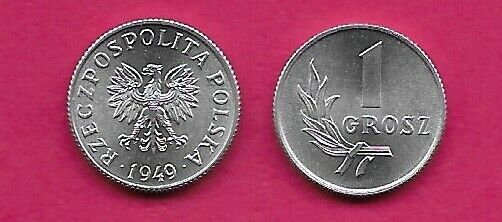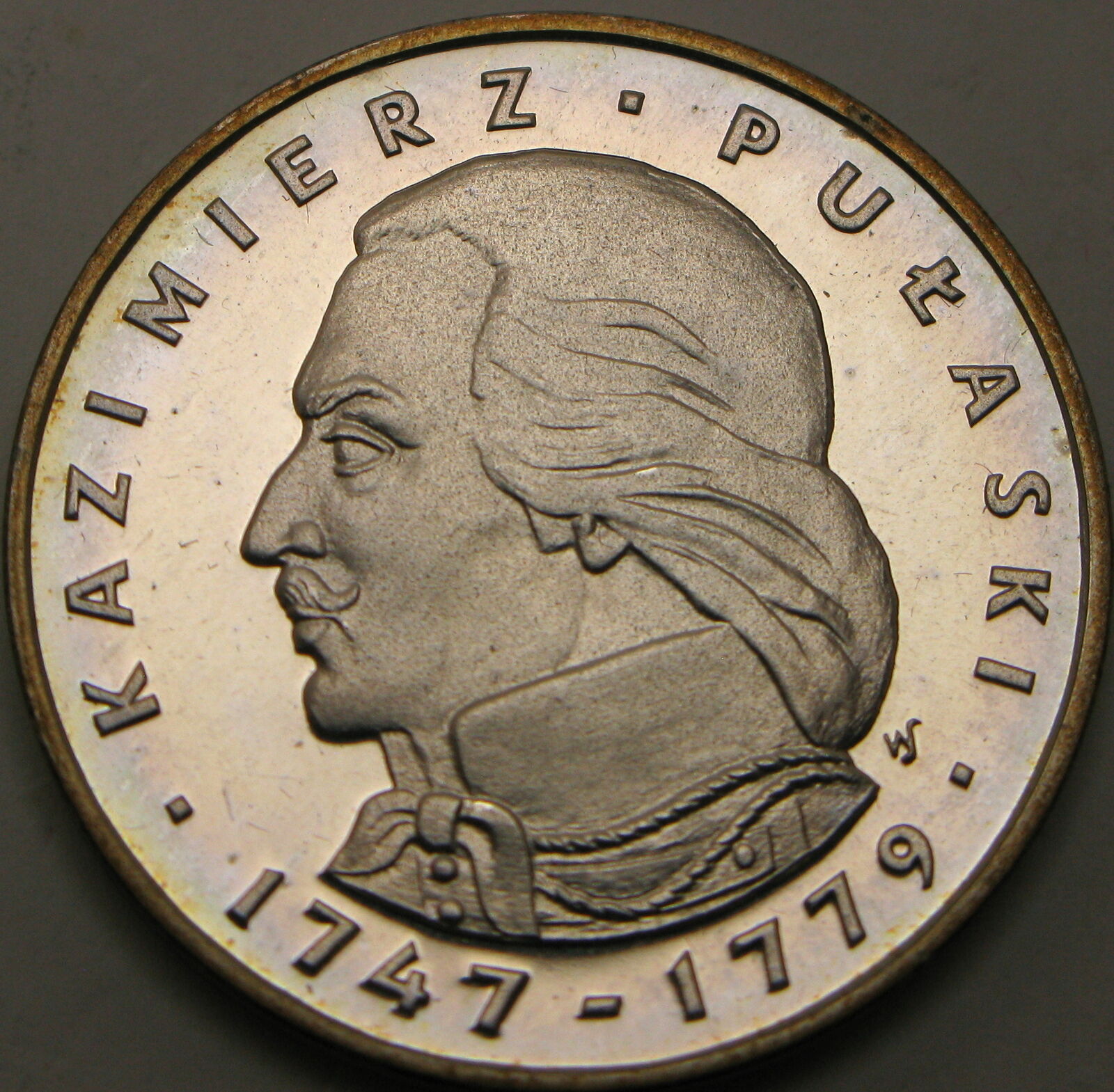-40%
Poland 1633 H Thaler City of Thorn! PCGS VF35 - Extremely Rare! Very Original.
$ 2085.6
- Description
- Size Guide
Description
Note: A similar piece, slightly later date, with damage, just sold at a Heritage Auction for nearly ,000. Will not sell to buyers in Minnesota.Poland 1633 H Thaler City of Thorn! PCGS VF35, and the ONLY piece graded by PCGS for this date and for this historic city of Thorn. An extremely rare and highly desirable coin. This is the only coin of it's kind certified by PCGS or NGC. This is the real deal and I have owned this coin for over 20 or more years. I never thought that I would sell this beauty, and have had many offers from dealers and other to buy it that I refused. But alas, there is a time for most things to have to be parted with. This was actually the first foreign coin that I ever bought. It is rare enough that copies exist. I have seen a few others, but the examples I have seen had planchet problems, but as you can see this coin is a problem-free and original coin, unmolested throughout the years. I will include a copy with this coin. This is a very important and impressive coin. Buyer to pay .00 for registered shipping to any approved country. PayPal, or certified check only please.
This coin was minted in the city of Torun (Thorn) 1633 under the Polish King, Wladislaw IV
Władysław IV (June 9, 1595 – May 20, 1648) was the son of Sigismund III Vasa and his wife Anna of Austria (also known as Anna Habsburg). Władysław IV reigned as King of the Polish-Lithuanian Commonwealth from November 8, 1632, to his death in 1648. In 1610 he was elected a Tsar of Russia however was never able to take the Muscovite throne and used the title of Grand Duke of Moscow until 1634. The throne during this time was instead held by Michael Romanov.
Obverse: The portrait of the king Wladislav IV Vasa, the date 1633
Reverse: The coat of arms of the city of Torun
Władysław IV
Władysław managed to prevent the Commonwealth becoming embroiled in the bloody Thirty Years' War that ravaged western Europe during his reign, and was fairly successful in defending the Commonwealth from invasion. He supported religious tolerance and carried out military reforms. He failed, however, to realize his dreams of fame and conquest, or to reform and strengthen the Commonwealth. His death marked the end of the Golden Age of the Commonwealth, as conflicts and tensions that Władysław had failed to resolve led in 1648 to the greatest of the Cossack uprisings — the Chmielnicki Uprising — and to Swedish invasion ("The Deluge").
Wladislaw used the title of the King of Sweden, although he had no control over Sweden whatsoever and never set foot in that country. He would continue his attempts to regain the Swedish throne, with similar lack of results as his father.
In internal politics he attempted to strengthen the power of the monarchy, but this was mostly thwarted by the szlachta, who valued their independence and democratic powers. Wladyslaw suffered continuing difficulties caused by the efforts of the Polish Sejm (parliament) to check the King's power and limit his dynastic ambitions. The Szlachta viewed Vladislaus' military dreams as an attempt to strengthen his position during war and thus the Sejm strongly opposed the majority of his plans for war (for example, with Sweden in 1635 or Turks in 1646), and usually thwarted them by denying the funds for military campaigns and withholding its co-signature on the declaration of war. Similarly, Wladislaw's foreign ambitions came to little, as his attempts to mediate in the Thirty Year's War between the warring German and Scandinavian powers came to nothing, and his support for the Habsburgs brought him almost nothing in return.
Wladislaw died in 1648, a year after the death of his son, on the eve of the Chmielnicki Uprising and The Deluge. He failed to realize his dreams of conquest and he did not reform the Commonwealth. Wladislaw managed to avoid involving the Commonwealth in the bloody Thirty Year's War but his legacy would end the Golden Era of the Commonwealth. The Cossacks, angered because Wladislaw's promises to them failed to materialize, were beginning their greatest revolt against Polish rule, which would be exploited by Swedish invasion.
Toruń (Thorn)
Copernicus was born in 1473 in the city of Toruń (Thorn), in Royal Prussia, an autonomous province of the Kingdom of Poland.
Toruń (['tɔruɲ] (help·info); German: Thorn (help·info); Kashubian: Torń, see also other names) is a city in northern Poland, on the Vistula river. It had 208,278 inhabitants in 2005. The mediaeval town, birthplace of Nicolaus Copernicus, is listed among the UNESCO World Heritage Sites.
Previously the capital of the Toruń Voivodeship (1975-98) and the Pomeranian Voivodeship (1921-39), Toruń is one of the capitals of the Kuyavian-Pomeranian Voivodeship since 1999 as the city created the bipolar agglomeration Bydgoszcz-Toruń with Bydgoszcz, located 45 km away. In September 2004, the Medical Academy in Bydgoszcz joined the Nicolaus Copernicus University in Toruń as the Collegium Medicum.
The first settlement in the vicinity is dated by archaeologists to 1100 BC. During medieval times there was a small settlement here guarding the crossing of the river (7th-13th centuries), but it was probably already abandoned by 1230.
When the Teutonic Knights arrived in Kulmer Land/Chełmno Land, they built a castle (1230-31) here. The settlement, named Thorn (after a castle owned earlier by the order in the Holy Land), acquired city rights in 1233 and was relocated in 1236 from its original site to Altstadt ("Old Town"), now called Stare Miasto. The town soon became a mostly German speaking medieval trade center. In 1263 Franciscan monks settled in Thorn/Toruń, and they were followed in 1239 by Dominicans. In 1264 the neighboring Thorner Neustadt (New Town) or Nowe Miasto was founded. It was a separate town until 1454, when the old and new cities were amalgamated.
During the 14th century, the city joined the mercantile Hanseatic League. The First Peace of Toruń ending the Polish-Lithuanian-Teutonic War (1409-1411) was signed in the city in 1411. When the Prussian nobility formed the Prussian Confederation in 1440, the city rose with the Confederation against the Teutonic Knights in 1454, and in return for support and recognition of its city privileges, Toruń accepted the sovereignty of the Polish crown. The resulting Thirteen Years' War ended in 1466 with the Second Peace of Toruń, in which the Teutonic Order ceded sovereignty over western Prussia (Royal Prussia) to the Kingdom of Poland.
The mostly German populated city adopted Protestantism in 1557 during the Protestant Reformation, while the majority of Poland remained Roman Catholic. During the time of mayer ("Bürgermeister") Heinrich Stroband (1586-1609) Toruń became centralised and power went into the hands of its city council. In 1595, Jesuits arrived in order to promote Counter-Reformation, taking control of the Church of St. John. Protestant city officials tried to limit the influx of the Catholic population into the city, as Catholics (Jesuits and Dominican Order monks) already controlled most churches, leaving only St. Mary to the Protestant citizens.
In 1677, the Prussian historian and educator Christoph Hartknoch was invited to be director of the Torunian Gymnasium, a post which he held until his death in 1687. Hartknoch wrote books on the history of Prussia, which included the Royal Prussian cities.
In the second half of the 17th century tensions between Catholics and Protestant grew. Just as the religious tensions in the rest of Europe settled down, after the bloody Thirty Years' War and Peace of Westphalia, in the once very tolerant Polish-Lithuanian Commonwealth the situation was worsening. Since 1682, the St. Mary's Church had to be guarded by a Lutheran Bürgerwehr (militia) during the Feast of Corpus Christi processions, as the assembled Catholics might have occupied this church as well. On 16 July 1724, when the Jesuits held another procession, a fight with pupils of the Lutheran Gymnasium led to the devastation of the Jesuit collegium. After this event, both Jesuits and Dominicans tried to persuade mayor Johann Gottfried Rößner and ten other leading citizens, all of them Prussian German Protestants, to convert to the Church of Rome. They declined and did not leave the city despite the pressure. The Jesuits then appealed to the Royal supreme court in Warsaw. The court, held during the monarchy of August II the Strong of Saxony, sentenced Rößner and nine other Lutherans to death [1], sparing only Rößner's predecessor Zerneke. The remaining Protestant church, St. Mary's, was also made Catholic again and given to Franciscan monks who celebrated a Mass there on the day of the execution, 7 December 1724, which is remembered for these Protestant martyrs [2]. Also, the majority of the town council had to be Catholics from then on. In large parts of Europe, this Toruń Blood tribunal (de:Thorner Blutgericht), reminiscent of witch hunts, damaged Poland's reputation of tolerance. Over 165 publications and countless newspapers reported about it. Decades later, during the Partitions of Poland, Voltaire recalled the events as an example "of religious intolerance of Poles". [3]
In 1793 the city was annexed by the Kingdom of Prussia following the Second Partition of Poland. In 1807, the city became part of the Duchy of Warsaw created by Napoleon and ruled by King Frederick Augustus I of Saxony, although Prussia took it over again upon Napoleon's defeat in 1814. In 1870, French prisoners of war taken during the Franco-Prussian War built a chain of forts surrounding the town. In the following year the city, along with the rest of Prussia, became part of the new German Empire.
In the Treaty of Versailles in 1919 after World War I, Toruń became part of the Poland as the capital of the Pomeranian Voivodeship, even though it was not situated in Pomerania. The Baltic Institute was established in the city in 1925 with the task of documenting Polish heritage in Pomerania. In general, the interwar period was a time of significant urban development in Toruń. Major investments were completed in areas like transportation (new streets, tramway lines and Piłsudski Bridge), residential constructions (many new houses, particularly in Bydgoskie Przedmieście) and public buildings.










